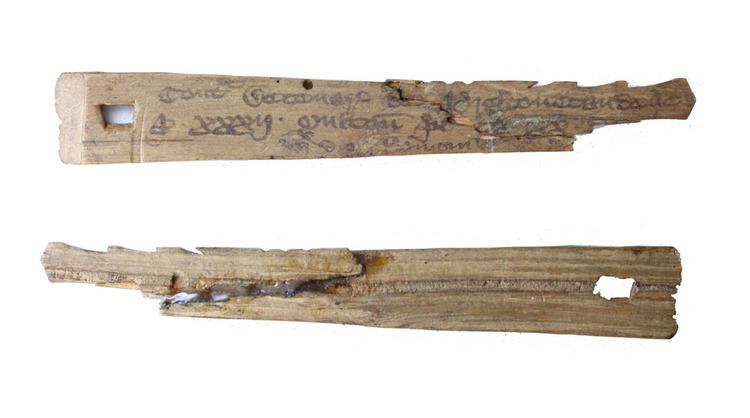 | ||
A tally stick (or simply tally) was an ancient memory aid device used to record and document numbers, quantities, or even messages. Tally sticks first appear as animal bones carved with notches during the Upper Paleolithic; a notable example is the Ishango Bone. Historical reference is made by Pliny the Elder (AD 23–79) about the best wood to use for tallies, and by Marco Polo (1254–1324) who mentions the use of the tally in China. Tallies have been used for numerous purposes such as messaging and scheduling, and especially in financial and legal transactions, to the point of being currency.
Contents
Kinds of tallies
Principally, there are two different kinds of tally sticks: the single tally and the split tally. A common form of the same kind of primitive counting device is seen in various kinds of prayer beads.
Paleolithic tally sticks
A number of anthropological artefacts have been conjectured to be tally sticks:
Single tally
The single tally stick was an elongated piece of bone, ivory, wood, or stone which is marked with a system of notches (see: Tally marks). The single tally stick serves predominantly mnemonic purposes. Related to the single tally concept are messenger sticks (e.g., Inuit tribes), the knotted cords, khipus or quipus, as used by the Inca. Herodotus (c. 485–425 BC) reported the use of a knotted cord by Darius I of Persia (c. 521–486 BC).
Split tally
The split tally was a technique which became common in medieval Europe, which was constantly short of money (coins) and predominantly illiterate, in order to record bilateral exchange and debts. A stick (squared hazelwood sticks were most common) was marked with a system of notches and then split lengthwise. This way the two halves both record the same notches and each party to the transaction received one half of the marked stick as proof. Later this technique was refined in various ways and became virtually tamper proof. One of the refinements was to make the two halves of the stick of different lengths. The longer part was called stock and was given to the party which had advanced money (or other items) to the receiver. The shorter portion of the stick was called foil and was given to the party which had received the funds or goods. Using this technique each of the parties had an identifiable record of the transaction. The natural irregularities in the surfaces of the tallies where they were split would mean that only the original two halves would fit back together perfectly, and so would verify that they were matching halves of the same transaction. If one party tried to unilaterally change the value of his half of the tally stick by adding more notches, the absence of those notches would be apparent on the other party's tally stick. The split tally was accepted as legal proof in medieval courts and the Napoleonic Code (1804) still makes reference to the tally stick in Article 1333. Along the Danube and in Switzerland the tally was still used in the 20th century in rural economies.
Split tally in England
The most prominent and best recorded use of the split tally stick (or "nick-stick") being used as a form of currency was when King Henry I initiated the tally stick system in or around 1100 in medieval England. He would accept the tally stick only for taxes, and it was a tool of the Exchequer for the collection of taxes by local sheriffs (tax farmers "farming the shire") for seven centuries. The split tally of the Exchequer was in continuous use until 1826. In 1834, the tallies themselves were ordered to be burned in a stove in the Houses of Parliament, but the fire went out of control setting the building afire. This event was described by Charles Dickens in an 1855 article on administrative reform.
The system of tally marks of the Exchequer is described in The Dialogue Concerning the Exchequer (see external links below) as follows:
The manner of cutting is as follows. At the top of the tally a cut is made, the thickness of the palm of the hand, to represent a thousand pounds; then a hundred pounds by a cut the breadth of a thumb; twenty pounds, the breadth of the little finger; a single pound, the width of a swollen barleycorn; a shilling rather narrower; then a penny is marked by a single cut without removing any wood.
The cuts were made the full width of the stick so that, after splitting, the portion kept by the issuer (the stock) exactly matched the piece (the foil) given as a receipt. Each stick had to have the details of the transaction written on it, in ink, to make it a valid record.
Royal tallies (debt of the Crown) also played an infamous role in the formation of the Bank of England at the end of the 17th century when these royal tallies, trading at a hefty discount of up to 60 percent, were engrafted into the Bank's capital stock.
Tally sticks feature in the design of the entrance gates to The National Archives at Kew.
